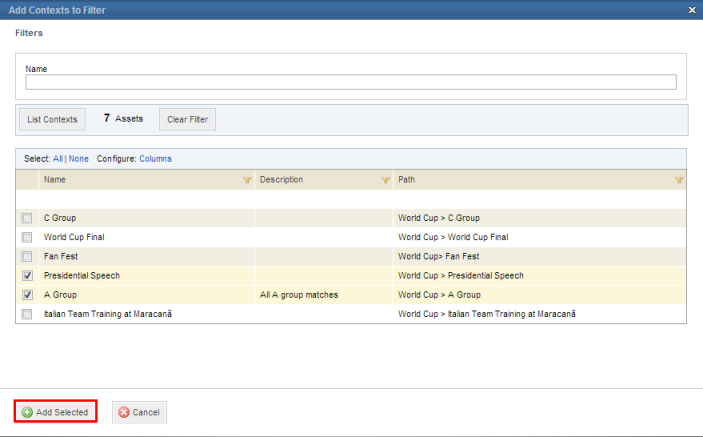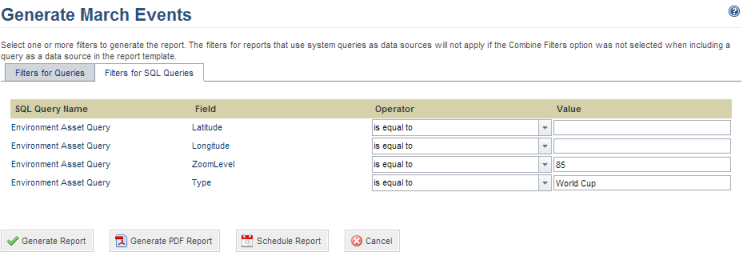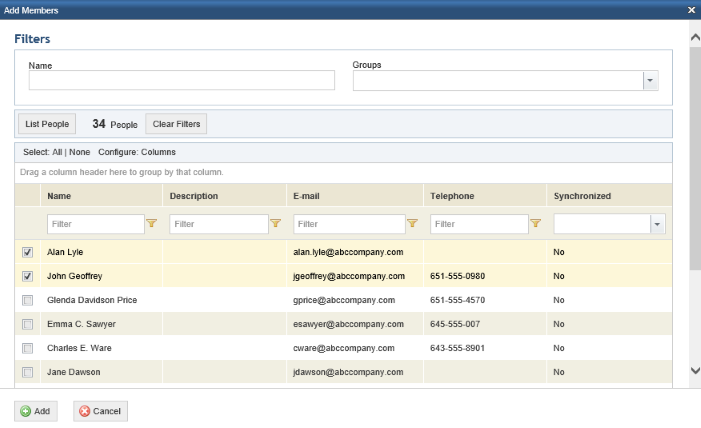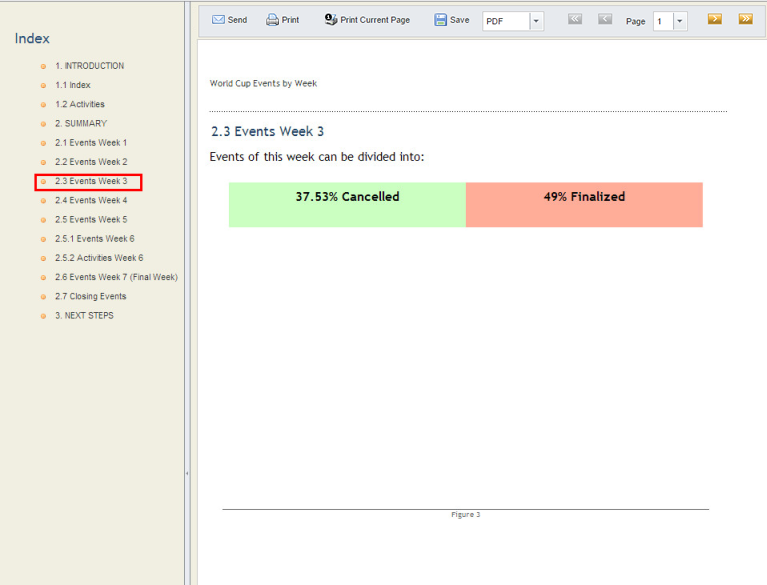How to Generate a Report for Scheduled Events
1.
Access the Events solution.
2.
Select Generate Reports from the Reports option on the menu.
The system displays the list of
report templates, grouped by language. All enabled generic report templates
created in this solution of which you are author or an audience member will be
displayed. The Template Type column indicates the type of report, while
the Status column indicates if the template is enabled or disabled. Only
enabled templates to which you have permission will appear in this section.
3.
Click Generate Report ( ) next to the report you want to
generate (see figure below). Note that you will only be able to generate reports
of which you are the author or part of the audience. However, template authors
and editors can also generate reports through the Manage Templates
section of this solution.
) next to the report you want to
generate (see figure below). Note that you will only be able to generate reports
of which you are the author or part of the audience. However, template authors
and editors can also generate reports through the Manage Templates
section of this solution.

The system displays a screen where
you can set filters to decide what will be displayed in the report. In the
Filters for Queries tab, you can set filters for reports as well as
filters for any queries included as data sources in the reports. Note that when
generating reports, the filters set for both system queries and reports will
apply if the Combine Filters option was enabled when including system
queries as data sources in the template. Otherwise, filters set for reports will
be disregarded and only the filters set for queries used in the template will
apply. The Filters for SQL Queries allows you to filter any SQL queries
included as data sources in generic reports by the columns selected as filter
options. The columns that will be set as filters in the report can be selected
after the SQL query is included in the report template.
4.
Select a type of filter from the list on the left and click Add to Filter
to select the objects that will be used to filter the report (see figure below).

Note: These filters will
only apply to default data sources. In other words, they will not work in SQL
queries included as data sources in the report.
5.
Select the objects to be added to the filter in the window that appears and
click Add Selected (see figure below). If you want to quit the operation,
click Cancel.

The system displays the objects
selected in the list of applied filters. The options with filters set can be
identified by the funnel icon ( ) next to them.
) next to them.
6.
To remove objects from the filter, mark the checkboxes next to those you want to
remove and click Remove from Filter.
7.
To remove all filters, click Clear Filter (see figure below).

8.
To set filters for any SQL queries included as data sources in a generic report,
click the Filters for SQL Queries tab (see figure below). Any
columns selected as filter options for each SQL query included as a data source
will be displayed. Note that columns can be set as filter options after the SQL
query is included in the report template.

9.
Select the operator in the Operator field next to each column from each
query you want to filter, and enter the values in the Value field.
10. When
finished setting the filters, click Generate Report. If you want to quit
the operation, click Cancel.
The system displays the report in a new window. Note that,
before generating a report, report templates must be exported and edited through
Report Designer for the content to be properly displayed in the report. For
details, see Chapter 14: Events -> Scheduled Event Reports -> How to
Manage Report Templates for Scheduled Events.
11. All reports
include a menu on top to facilitate navigation. If you want to send the report
via e-mail, click Send. The message template for sending reports and the
message service must have been configured correctly in the Administration
module.
The system displays an area where
you can specify recipients for the e-mail. You can insert e-mail addresses by
clicking To (see figure below) or manually, separating each address by a
semicolon. The system accepts a maximum of 30 e-mail addresses at a time.

If, for example, you selected
Person, the system displays a window where you can select the people to
which you want to send the report (see figure below).

12. Once
finished specifying recipients, click Send PDF (see figure below).

The system displays a success
message.
13. To print a
full report, click Print, or select Print Current Page to only
print the page you are viewing.

14. To save a
report, select either PDF or RTF as the format from the drop-down list and click
Save.
15. In the
dialog box that appears, click Open to open the report in the format
selected on your computer, or click Save. If you want to quit the
operation, click Cancel.
16. The
navigation buttons from this menu can be used to browse through the report’s
pages. Click First Page ( ) to go to the beginning of the
report; click Previous Page (
) to go to the beginning of the
report; click Previous Page ( ) to go to the previous page; click
Next Page (
) to go to the previous page; click
Next Page ( ) to go to the next page in the
report; and click Last Page (
) to go to the next page in the
report; and click Last Page ( ) to skip to the end.
) to skip to the end.
17. To navigate
the report pages, you can also select the page from the drop-down list from the
Page field.
18. You can
also browse the report by clicking the name of a topic from the table of
contents on the left (see figure below).

19. When
finished viewing the report, click Close in the upper right corner of the
screen. Reports can be generated again at any time to view updated results.
 ) next to the report you want to
generate (see figure below). Note that you will only be able to generate reports
of which you are the author or part of the audience. However, template authors
and editors can also generate reports through the Manage Templates
section of this solution.
) next to the report you want to
generate (see figure below). Note that you will only be able to generate reports
of which you are the author or part of the audience. However, template authors
and editors can also generate reports through the Manage Templates
section of this solution.













